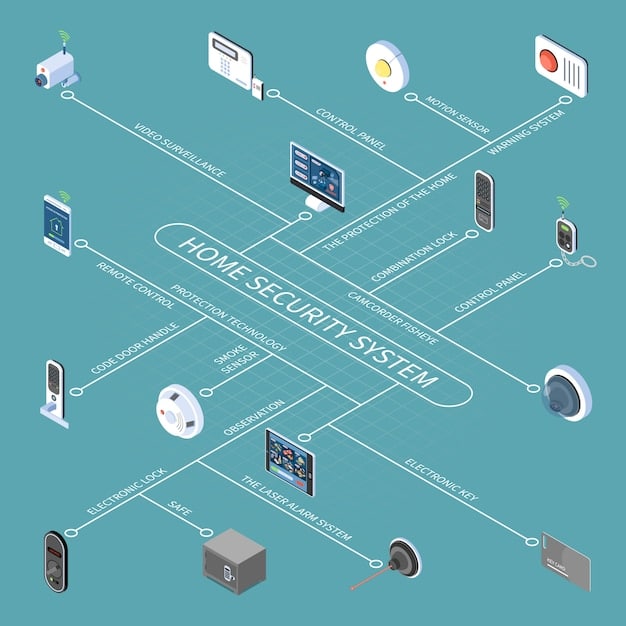Intrusion Detection Systems (IDS): US Configuration and Tuning Guide

Intrusion Detection Systems (IDS) are crucial for US organizations, requiring careful configuration and tuning to minimize false alarms and maximize threat detection by understanding network behavior and tailoring rules.
In the United States, robust cybersecurity measures are paramount, and Intrusion Detection Systems (IDS): Configuring and Tuning Your IDS to Minimize False Alarms and Maximize Threat Detection in US play a vital role in safeguarding sensitive data and critical infrastructure. Proper configuration and ongoing tuning are essential to ensure that these systems accurately identify and respond to genuine threats, rather than overwhelming security teams with false positives.
Understanding Intrusion Detection Systems
Intrusion Detection Systems (IDS) are designed to monitor network traffic and system activity for malicious activity or policy violations. They act as a security alarm system, alerting administrators to potential threats so they can investigate and take appropriate action.
IDS solutions come in various forms, each with its strengths and weaknesses. Understanding the different types of IDS is crucial for selecting the right solution and configuring it effectively.
Types of Intrusion Detection Systems
There are several types of IDS, each with a different approach to threat detection:
- Network Intrusion Detection Systems (NIDS): Monitors network traffic for suspicious patterns.
- Host Intrusion Detection Systems (HIDS): Monitors activity on individual hosts or endpoints.
- Signature-Based IDS: Detects known threats by comparing network traffic or system activity to a database of signatures.
- Anomaly-Based IDS: Establishes a baseline of normal network or system behavior and detects deviations from that baseline.

Choosing the right type of IDS depends on your specific security needs and the characteristics of your network environment. Once you’ve chosen an IDS, proper configuration is the next step.
Initial Configuration for Optimal Performance
The initial configuration of your IDS is crucial for setting the stage for effective threat detection. This involves defining the scope of monitoring, configuring sensors, and defining initial rules.
Failure to properly configure the system can lead to missed threats or excessive false alarms. A well-planned configuration ensures that the IDS is focused on the most critical assets and threats.
Defining Monitoring Scope
Determine what areas of your network or systems the IDS should monitor:
- Identify critical assets and prioritize monitoring efforts.
- Segment your network and deploy sensors strategically.
- Consider monitoring both internal and external traffic.
Configuring Sensors
Properly setting up your sensors is vital for capturing the necessary data:
- Position sensors to capture relevant network traffic.
- Ensure sensors have sufficient processing power and storage.
- Configure sensors to forward alerts to a central management console.
By thoughtfully defining the monitoring scope and configuring sensors, you can improve the accuracy and efficiency of your IDS.
Understanding False Positives and False Negatives
False positives and false negatives are two types of errors that can occur with Intrusion Detection Systems. Understanding these errors is crucial for effectively tuning your IDS.
Both types of errors can have significant consequences. False positives can waste valuable time and resources, while false negatives can lead to undetected breaches.
False Positives
A false positive occurs when an IDS identifies legitimate activity as malicious. This can be caused by overly sensitive rules, outdated signatures, or misconfiguration.
False Negatives
A false negative occurs when an IDS fails to detect malicious activity. This can be caused by overly permissive rules, gaps in coverage, or sophisticated attacks that evade detection.

Striving for a balance between minimizing false positives and false negatives is an ongoing process that requires continuous monitoring and tuning.
Tuning IDS Rules to Minimize False Alarms
Tuning IDS rules is essential for reducing the number of false alarms. This involves adjusting the sensitivity of rules, creating exceptions, and using whitelists.
Effective rule tuning can significantly improve the efficiency of your security team by reducing the noise and allowing them to focus on genuine threats.
Adjusting Rule Sensitivity
Fine-tune the sensitivity of rules to better match your environment:
- Lower the sensitivity of rules that generate excessive false positives.
- Increase the sensitivity of rules that are not detecting known threats.
- Use thresholds to trigger alerts only when activity exceeds a certain level.
Creating Exceptions
Create exceptions for legitimate activity that triggers alerts:
- Identify common sources of false positives and create exceptions for them.
- Use contextual information to differentiate between legitimate and malicious activity.
- Document exceptions thoroughly to ensure they are properly understood and maintained.
Using Whitelists
Implement whitelists to allow known good traffic to pass through without triggering alerts:
- Create whitelists for trusted IP addresses, domains, and applications.
- Regularly review and update whitelists to ensure they remain accurate.
- Use whitelists in conjunction with other security measures.
Regularly review and update your IDS rules to ensure they remain effective in detecting threats while minimizing false alarms.
Maximizing Threat Detection Capabilities
Maximizing threat detection capabilities requires a proactive approach to security. This involves staying up-to-date on the latest threats, implementing advanced detection techniques, and integrating the IDS with other security tools.
Proactive threat detection can help you identify and respond to threats before they cause significant damage.
Leveraging Threat Intelligence
Utilize threat intelligence feeds to stay informed about the latest threats:
- Subscribe to reputable threat intelligence feeds.
- Integrate threat intelligence data into your IDS.
- Use threat intelligence to prioritize alerts and investigations.
Implementing Advanced Detection Techniques
Implement advanced detection techniques to identify sophisticated attacks:
- Use anomaly detection to identify deviations from normal behavior.
- Implement behavioral analysis to detect suspicious patterns of activity.
- Use machine learning to improve the accuracy and effectiveness of detection.
By leveraging threat intelligence and implementing advanced detection techniques, you can significantly improve your ability to detect and respond to threats.
Regular Monitoring and Maintenance
Regular monitoring and maintenance are essential for ensuring the ongoing effectiveness of your Intrusion Detection System. This involves reviewing logs, updating signatures, and testing the system.
Consistent monitoring and maintenance can help you identify and address issues before they impact your security posture.
Reviewing Logs
Regularly review IDS logs to identify potential threats and anomalies:
- Establish a process for regularly reviewing logs.
- Use analytics tools to identify patterns and trends.
- Investigate suspicious activity promptly.
Updating Signatures
Keep your IDS signatures up-to-date to protect against the latest threats:
- Subscribe to automatic signature updates.
- Test new signatures before deploying them to production.
- Review and remove outdated signatures.
Testing the System
Periodically test the system to ensure it is functioning properly:
- Conduct penetration testing to identify vulnerabilities.
- Simulate attacks to test the IDS’s detection capabilities.
- Review and update the IDS configuration based on test results.
By adhering to these best practices, US organizations can optimize their Intrusion Detection Systems to minimize false alarms and maximize threat detection, strengthening their overall cybersecurity defenses.
| Key Point | Brief Description |
|---|---|
| 🛡️ IDS Types | NIDS, HIDS, Signature-Based, Anomaly-Based IDS explained. |
| ⚠️ False Positives/Negatives | Understanding and minimizing these errors is crucial. |
| ⚙️ Tuning IDS Rules | Adjust sensitivity, create exceptions, use whitelists. |
| 🔄 Regular Maintenance | Review logs, update signatures, and system testing. |
Frequently Asked Questions
▼
The primary function of an IDS is to monitor network traffic and system activity for malicious behavior or policy violations, providing alerts to security personnel.
▼
Signature-based IDS detect known threats using a database of signatures, while anomaly-based IDS identify deviations from established normal behavior.
▼
False positives are alerts triggered by legitimate activity, while false negatives are failures to detect actual malicious activity.
▼
Regularly updating IDS signatures ensures protection against the latest known threats and vulnerabilities, improving detection accuracy.
▼
Threat intelligence feeds provide up-to-date information on emerging threats, allowing IDS to proactively identify and respond to new attacks effectively.
Conclusion
In conclusion, configuring and tuning Intrusion Detection Systems (IDS) is crucial for minimizing false alarms and maximizing threat detection for US organizations. By understanding the nuances of IDS, tuning rules effectively, and maintaining continuous monitoring, businesses can significantly enhance their cybersecurity posture and protect against evolving threats.





